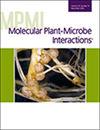求助PDF
{"title":"Suppression of a Transketolase Mutation Leads to Only Partial Restoration of Symbiosis in <i>Sinorhizobium meliloti</i>.","authors":"Sabhjeet Kaur, Justin P Hawkins, Ivan J Oresnik","doi":"10.1094/MPMI-02-25-0017-R","DOIUrl":null,"url":null,"abstract":"<p><p>The interaction between <i>Sinorhizobium meliloti</i> and alfalfa is a well-studied model system for symbiotic establishment between rhizobia and legume plants. Proper utilization of carbon sources has been linked with effective symbiotic establishment in <i>S. meliloti</i> strain Rm1021. Previous work has shown that mutation of the gene <i>tktA</i>, which encodes a transketolase involved in the pentose phosphate pathway, resulted in a strain impaired in many biological functions, including the ability to establish symbiosis with alfalfa. Work with this strain revealed the appearance of suppressor mutations that could partially revert the symbiotic phenotype associated with a <i>tktA</i> mutation. Characterization of these suppressor strains showed that carbon phenotypes associated with a mutation in <i>tktA</i> were no longer present and that the production of succinoglycan was partially restored. Central carbon metabolite pools were observed to be different compared with the wild-type and <i>tktA</i> mutant strains. Multiple independent mutations were identified in the gene <i>SMc02340</i>, a Gnt-type negative regulator, upon sequencing. RT-PCR suggested that <i>SMc02340</i> acts as a negative regulator on an operon containing the gene <i>tktB</i>, which becomes upregulated when the suppressor mutation is present or <i>SMc02340</i> is removed. Microscopic analysis revealed a unique symbiotic phenotype. The <i>tktA</i> mutant strain induced root hair curling but could not colonize the apoplastic space. Collectively, the data suggest that the upregulation of <i>tktB</i> can partially bypass some blocks associated with a lesion in <i>tktA</i>, including the colonization of the curled root hair, but cannot fully compensate for the loss of <i>tktA</i>. [Formula: see text] Copyright © 2025 The Author(s). This is an open access article distributed under the CC BY-NC-ND 4.0 International license.</p>","PeriodicalId":19009,"journal":{"name":"Molecular Plant-microbe Interactions","volume":" ","pages":"505-517"},"PeriodicalIF":3.4000,"publicationDate":"2025-07-01","publicationTypes":"Journal Article","fieldsOfStudy":null,"isOpenAccess":false,"openAccessPdf":"","citationCount":"0","resultStr":null,"platform":"Semanticscholar","paperid":null,"PeriodicalName":"Molecular Plant-microbe Interactions","FirstCategoryId":"99","ListUrlMain":"https://doi.org/10.1094/MPMI-02-25-0017-R","RegionNum":3,"RegionCategory":"生物学","ArticlePicture":[],"TitleCN":null,"AbstractTextCN":null,"PMCID":null,"EPubDate":"2025/7/25 0:00:00","PubModel":"Epub","JCR":"Q2","JCRName":"BIOCHEMISTRY & MOLECULAR BIOLOGY","Score":null,"Total":0}
引用次数: 0
引用
批量引用
Abstract
The interaction between Sinorhizobium meliloti and alfalfa is a well-studied model system for symbiotic establishment between rhizobia and legume plants. Proper utilization of carbon sources has been linked with effective symbiotic establishment in S. meliloti strain Rm1021. Previous work has shown that mutation of the gene tktA , which encodes a transketolase involved in the pentose phosphate pathway, resulted in a strain impaired in many biological functions, including the ability to establish symbiosis with alfalfa. Work with this strain revealed the appearance of suppressor mutations that could partially revert the symbiotic phenotype associated with a tktA mutation. Characterization of these suppressor strains showed that carbon phenotypes associated with a mutation in tktA were no longer present and that the production of succinoglycan was partially restored. Central carbon metabolite pools were observed to be different compared with the wild-type and tktA mutant strains. Multiple independent mutations were identified in the gene SMc02340 , a Gnt-type negative regulator, upon sequencing. RT-PCR suggested that SMc02340 acts as a negative regulator on an operon containing the gene tktB , which becomes upregulated when the suppressor mutation is present or SMc02340 is removed. Microscopic analysis revealed a unique symbiotic phenotype. The tktA mutant strain induced root hair curling but could not colonize the apoplastic space. Collectively, the data suggest that the upregulation of tktB can partially bypass some blocks associated with a lesion in tktA , including the colonization of the curled root hair, but cannot fully compensate for the loss of tktA . [Formula: see text] Copyright © 2025 The Author(s). This is an open access article distributed under the CC BY-NC-ND 4.0 International license.
抑制转酮醇酶突变只会部分恢复共生关系。
根瘤菌与紫花苜蓿的相互作用是根瘤菌与豆科植物建立共生关系的模式系统。碳源的合理利用与S. meliloti菌株Rm1021有效的共生关系有关。先前的研究表明,编码戊糖磷酸途径中的转酮醇酶的基因tktA突变导致菌株的许多生物学功能受损,包括无法与苜蓿建立共生关系。对该菌株的研究揭示了抑制突变的出现,这种突变可以部分地恢复与tktA突变相关的共生表型。这些抑制菌株的特征表明,与tktA突变相关的碳表型不再存在,琥珀聚糖的生产部分恢复。与野生型和tktA突变株相比,中心碳代谢物池有所不同。基因SMc02340是一种gnt型负调控基因,经测序发现该基因存在多个独立突变。RT-PCR提示SMc02340在含有tktB基因的操纵子上起负调控作用,当抑制突变存在或SMc02340被移除时,该基因就会上调。显微分析显示出独特的共生表型。tktA突变株诱导根毛卷曲,但不能定殖外质体空间。总的来说,这些数据表明,tktB的上调可以部分绕过与tktA病变相关的一些阻滞,包括卷曲根毛的定植,但不能完全补偿tktA的损失。
本文章由计算机程序翻译,如有差异,请以英文原文为准。

 求助内容:
求助内容: 应助结果提醒方式:
应助结果提醒方式:


